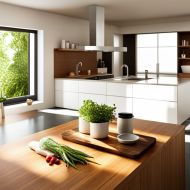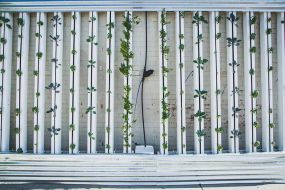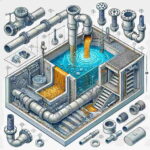Category Archives: Gardening
Essential Components of an Indoor Hydroponic Garden Setup

In recent years, the concept of an indoor hydroponic garden has gained immense popularity among urban dwellers and gardening enthusiasts alike. These innovative setups offer a sustainable and efficient way to grow fresh produce right in the comfort of one’s home or office. But what exactly goes into setting up a successful indoor hydroponic garden?
Understanding An Indoor Hydroponic Garden: Beyond Soil
At its core, an indoor hydroponic garden is a method of growing plants without soil, using a nutrient-rich water solution instead. This innovative approach allows for greater control over the plant’s environment, leading to faster growth and higher yields. By eliminating soil, gardeners can avoid many common pests and diseases that typically plague traditional gardens. Additionally, hydroponic systems are often more water-efficient, recycling water continuously, and reducing the overall consumption. But, what do you need to set up an efficient indoor hydroponic garden?
Hydration and Nutrition: The Lifeline of Hydroponics
Water and nutrient solution plays a pivotal role. In an indoor hydroponic garden, plants draw their nutrients directly from the water. This means the quality of the water and the balance of the nutrient solution are paramount to the health and productivity of the garden. Additionally, it’s noteworthy that an indoor hydroponic garden’s reliance on this nutrient-rich water solution contributes significantly to water conservation, using a remarkable 90% less water than traditional soil-based gardening methods.
Shedding Light on Growth: The Role of Lighting
Lighting is another essential component. Plants require light to photosynthesize and grow. In an indoor hydroponic garden setup, natural sunlight might be scarce or inconsistent. This is why artificial lighting, such as LED grow lights, becomes vital to ensure plants receive the right amount of light when in an indoor environment.
Modern Farming: The Age of Automation
Last but not least, modern indoor hydroponic gardens often incorporate advanced control systems, standing out as examples of technological evolution. These state-of-the-art systems are designed to take the guesswork out of gardening. With features like smart sensors and Wi-Fi connectivity, they can continuously monitor the garden’s environment, adjusting settings in real-time to maintain ideal growth conditions, ensuring that gardeners can manage their crops from anywhere, anytime. Their optimized LED lighting ensures plants receive the right amount of light, regardless of external conditions. Furthermore, some of these systems are equipped to provide timely alerts, such as when it’s time to harvest or if there’s a change in nutrient levels. This level of automation not only simplifies the gardening process but also ensures that plants receive consistent care, leading to healthier crops and higher yields. In essence, with these smart systems, an indoor hydroponic garden is not just automated but also more connected and responsive than outdoor methods.
Diverse Choices with Seed Pods in Hydroponic Systems
One of the standout features of a modern indoor hydroponic garden is the use of seed pods. These pods, offering a selection of several diverse crops, are meticulously designed to provide an optimal environment for seeds to germinate and sprout. Whether you’re looking to grow butter lettuce, shiso, Portuguese kale, chamomile, or any of the other numerous options, there’s a seed pod tailored for it. Pre-packed with the right amount of nutrients and a growth medium, they eliminate the need for soil, ensuring a cleaner and more efficient planting process. The convenience of seed pods also means that users can easily switch between different crops without the hassle of traditional planting. Once inserted into the hydroponic system, these pods receive the perfect balance of water, light, and nutrients, ensuring robust and healthy plant growth. Moreover, the use of seed pods reduces the chances of contamination from soil-borne diseases, making them a safer choice for indoor gardening.
Setting up an indoor hydroponic garden can be a rewarding experience, offering fresh produce year-round. While there are several components to consider, these systems make the growing process seamless and straightforward. If you’re considering starting your own indoor hydroponic garden, there’s no better time than now. With smart technology leading the way, you’re sure to have a thriving garden in no time at all. Are you ready to embark on your hydroponic journey?
Essential Indoor Gardening Supplies and Tools You Need

In recent years, indoor gardening has gained significant popularity among both novice and experienced gardeners. Creating a thriving indoor garden can bring a touch of nature and a sense of tranquility to your living space, regardless of whether you live in a spacious house or a cozy apartment. However, to ensure your plants flourish, you need the right supplies and tools at your disposal. Luckily, indoor growing systems make growing greens, edible flowers, and herbs simple and easy.
Indoor Gardening Supplies
In order to be successful with traditional indoor gardening, you will need a number of tools and supplies. Automated growing systems aim to make growing indoors as simple as possible and most of these tools are not required for these growing systems. But if you are planning on growing outside of one of these systems, you will probably need the following:
- Plant Containers and Pots
Opt for containers with proper drainage to prevent overwatering, which is a common issue in indoor gardening. You can choose from a variety of materials such as ceramic, terracotta, plastic, and fabric pots. Each has its benefits, so consider your specific plants’ needs and your aesthetic preferences.
- Potting Mix and Soil Amendments
There are specialized potting mixes available for various types of plants, such as succulents, herbs, and tropical plants. Additionally, soil amendments like perlite and vermiculite can improve drainage and water retention, promoting healthy root growth.
- Lighting Systems
Indoor plants rely on artificial light sources, especially when natural light is limited. High-quality grow lights are a must-have for your indoor garden. Depending on your plant selection, you might need different light intensities and durations, so research your plants’ light requirements thoroughly.
- Watering Can or System
Proper watering is crucial for the well-being of your indoor plants. A watering can with a narrow spout allows for controlled watering, preventing soil erosion and waterlogging. Alternatively, you can opt for automated watering systems with timers.
- Pruning and Trimming Tools
Invest in a pair of sharp and sturdy gardening shears for cutting away dead leaves, shaping plants, and encouraging new growth. Pruning also helps prevent pests and diseases from spreading.
- Humidity Trays and Misters
To enhance humidity levels around your plants, consider using humidity trays filled with water and placing them nearby. You can also use a fine misting spray to mimic a tropical environment, which is especially beneficial for orchids and ferns.
- Plant Fertilizers
Choose a balanced liquid fertilizer or slow-release granular fertilizer to provide essential nutrients that might be lacking in the potting mix. Be sure to follow the recommended dosage instructions to avoid over-fertilization.
Creating a lush and vibrant indoor garden requires a number of supplies and a certain amount of knowledge in order to be successful. That’s why selecting a simple plug-and-grow indoor garden system that allows you to have beautiful, nutritious, and convenient home-grown greens, without the need for all the extra tools and supplies, is an excellent choice.
What are the Essentials for Your Smart Garden?

Isn’t it wonderful to have fresh greens and garden vegetables on hand whenever they are wanted? It is also wonderful to have a garden to take care of. It is mentally rewarding as well as a treat for the body. Even without having a lot of outdoor space available, it is still possible to have a garden. A smart garden is easy to own, no matter the circumstances, and easy to sustain as part of any lifestyle.
What is a Smart Garden?
A smart garden is a hydroponic, indoor garden that is automated just like any smart home or office. These garden units take the guess work out of gardening and provide the freshest nutritious produce all year round. People love gardening indoors without the hassle of weather or pests.
The best indoor gardening units are designed to take up very little space while still allowing for multiple plants to be grown at once. Superior smart gardens use vertical growing technology and include growing shelves to increase capacity without increasing the footprint.
These innovative growing units use specialized sensors and cameras to monitor the progress of each plant. As the plant grows, the nutrient/water solution can be adjusted automatically and the lighting can be customized in order for the plants to get the optimum growing environment.
Save Water with Hydroponics
Most indoor gardening is done with hydroponic methods, which means that the smart garden uses its own watering system. The plants still need moisture, but with an indoor garden, the water is controlled and less is required. A major benefit of a smart garden is that it has technology that automatically senses all of the plant’s needs. The sensors can tell the temperature of the garden, monitor when water is needed, and make sure the garden does not get waterlogged.
Nutrients On-Demand
A smart garden that grows hydroponically uses a specific blend of nutrients that is mixed into the water. As the water circulates around the roots, the plants can absorb the correct amount of plant nutrients, oxygen, and water needed to grow.
The technology that supports these smart gardens detects the nutrient and water levels and automatically adjusts to maintain an optimum balance. It is not even necessary to be at home to take care of the garden. Water, light, and nutrients are all precisely timed and fully automated.
Smart Lighting Is a Garden Essential
Grow lights in an indoor garden are one of the essential components required for growing healthy and lush plants inside. Optimized LED lights that are fully automated can help plants to grow 2 to 3 times faster.
The lights in a smart garden are controlled with sensors and a computer. Indoor gardens have LED lights which use less energy than house lighting and can be left on to provide steady lighting all day.
The Main Thing to Know About the Smart Garden
All gardens do need the same things in order to be healthy and productive: water, nutrients, and light. An indoor, vertical smart garden is no different. The right amount of these three essential components balanced perfectly will produce incredible and nutritious products that can be enjoyed immediately after harvesting.
These innovative indoor gardens not only bring nutritious food straight to the table, but they also give individuals the pleasure of gardening indoors, year-round. Fresh greens, herbs, and edible flowers growing indoors make for a beautiful and satisfying hobby.
A smart garden is made even easier and more enjoyable through a monthly subscription which delivers everything needed straight to the door.
What is Left for the Gardener to Do?
There are plenty of things to do when managing a smart garden. It requires monitoring and understanding. Depending on the crop that is growing, gardeners may need to learn how to hand pollinate plants like tomatoes, peppers, or strawberries.
The gardener is also required to decide what to grow. They also pick and enjoy the fresh herbs and vegetables when they are ready.
A smart garden can think for itself, but that does not mean that it does not give the same joys and provide all the benefits of any other garden. The future of gardening is indoors and very smart.
Five Reasons You Should Have a Vertical Garden

Many people are choosing to grow their own produce at home. Whether it is because of food costs, access to fresh vegetables, or just as a fun hobby, indoor gardening is becoming more popular every day. Some further benefits to indoor vertical gardens include:
1) Maximized Space
Living in an apartment or small home leaves little room for a traditional garden. The large amounts of soil and space required for planting a variety of greens is virtually impossible to fit onto an apartment balcony or small backyard.
Fortunately, a vertical garden can solve all these problems. Made for indoor use, vertical gardens have been crafted to maximize a small amount of space. The many tiered levels reduce the amount of floor space needed; the structure expands upward rather than outward.
Through hydroponic systems, vertical gardens can also eliminate the need for soil. This allows more plants to be added, reducing the overall amount of space needed.
2) Simple Organization
Because the hydroponic system relies on each plant receiving the proper amounts of water and light, the possible locations for plants are preplanned by the manufacturer. This makes organization very simple.
Not every plant requires the same amounts of light, but many have similar light cycles. Vertical gardens are often arranged in easily accessible rows or sections by light. This makes it easy to group plants that require different types and amounts of light together.
The simplicity of rows also makes it easy to see which plants grow faster, allowing the gardener to place those that require regular harvesting to be placed in the most accessible locations. This makes gardening with a vertical garden enjoyable and stress free, as everyone is able to organize their plants exactly how they want.
3) Easy Maintenance
In a traditional garden, there are many maintenance tasks that must be carried out regularly, sometimes every day, to ensure the health of the growing plants. These include watering, weeding and shading. In a vertical garden, the hydroponic system takes care of all these tasks.
In a hydroponic system, nutrient rich water is pumped around the roots of every plant, allowing easy access to all the nutrients the plants need to grow and thrive. Because of the enclosed nature of vertical gardens, along with the lack of extra space, weeds are a rare occurrence.
The hydroponic system also allows the light cycle to be adjusted independently for different levels and bulbs in the vertical garden. This allows each plant to get the right amount of light with no extra fuss.
The only maintenance task required, aside from harvesting and planting greens and herbs, is keeping the water reservoir filled. Hydroponic systems rely on water to feed each plant nutrients, so these levels must be maintained. Vertical gardens come with a water reservoir and dissolvable nutrient packets for each refill.
4) Optimal Growing Environment
Traditionally, plants use large, branched root systems to absorb water and nutrients from the soil. Growing and energizing these systems uses a large amount of the plants’ available energy and often does not result in maximum absorption. This inefficiency in nutrient collection makes it more difficult for plants to grow to their full potential.
A vertical garden eliminates this issue. In hydroponic systems, the water pumped through the garden is full of all the nutrients the plants need. With the nutrients brought to them, all the plants need to do is absorb them. Because they are not required to spend energy enhancing their root system to find nutrients, plants in a vertical garden are able to grow and mature two to three times faster.
5) A Diverse Vertical Garden
Due to the variety of light settings and constant nutrient fuel, many different types of plants can be grown in a vertical garden. A variety of fruits and vegetables, such as cucumbers, tomatoes, beans and strawberries, are quite popular for vertical gardens. With larger plants, it’s important to consider the size of the vertical garden before planting seeds. If a plant grows too tall for the vertical garden, it should not be planted.
Edible greens such as lettuce, kale or spinach are also popular, along with herbs such as basil or dill. These plants are typically smaller and thrive in hydroponic vertical gardens. Once they reach maturity, these plants can provide fresh flavors all year.
Vertical gardens are a great way to grow fresh produce, whether there is space for a traditional garden or not. They allow plants to thrive and mature quickly, requiring a very small amount of maintenance. With a vertical garden and a little bit of care, any kitchen can be supplied with fresh produce and greens.







